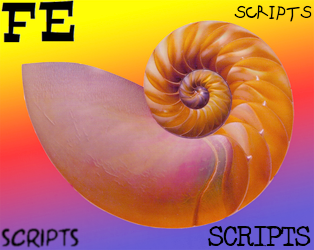FE Nautilus Scripts
Script Naming Convention
(4-part script names)
( FE = Freedom Environment )

Unusual text fonts were added
to this image using the
'TitleBlock' FE 'tkGooie'
in the 'IMAGEtools' group.
FE Nautilus ScriptsScript Naming Convention(4-part script names)( FE = Freedom Environment ) |

Unusual text fonts were added to this image using the 'TitleBlock' FE 'tkGooie' in the 'IMAGEtools' group. |
! Note !
This page may be touched up or revised occasionally
--- especially after a new release of 'feNautilusScripts'.
|
INTRODUCTION : After about a year and a half of fairly constant development and usage of the 'feNautilusScripts' (from mid-2010 to early-2012), I finally determined a suitable naming convention to use for the names of the script files. A little history: I initially developed a set of about 20 Image Processing scripts. Then I found that there were at least 10 other categories of scripts that I wanted to develop. I found that I could put the scripts in separate sub-directories of my Nautilus scripts directory --- which was the '.gnome2/nautilus-scripts' directory of one's home directory. I soon had a set of Nautilus utility scripts organized into the following categories (and directories) :
Note that when you open the Nautilus 'Scripts >' menu of the Nautilus file manager and go to one of these subgroups of scripts, each subgroup menu shows the filenames that were given to the script files in that subgroup. The naming of the scripts in each subgroup is important to understanding how to use the scripts. (The ordering and grouping of the scripts within each subgroup menu can be helpful too.) Over the afore-mentioned development-usage time period (mid-2010 to early-2012), I had been changing the names of some of the scripts in each release of 'feNautilusScripts' --- especially as I went to use a script but found that I could no longer remember some aspect of the script. I often found that the name I had given to a script did not adequately communicate to me some feature of its usage, such as
During a period of intense development of about thirty scripts in the subgroups 'imgEFFECTStools' and 'imgANIGIFtools' of the 'IMAGEtools' subgroup, I finally devised a naming convention that would solve most of my issues in using (and naming) the scripts. The NAMING CONVENTION : The naming convention is based on the following 4-part name structure. [part1]_[part2]_[part3]_[part4].sh The parts are separated by the underscore character and every script ends in the 'extension' '.sh'. The parts are described as follows.
Within each 'part' of the filename, a combination of upper- and lower-case letters may be used --- and some separators may be used, such as hyphens ... or more underscores. Some examples --- chosen with particular attention to demonstrating various examples of 'part2', the file-selection indicator:
The Parts - discussed : Part1 - discussion: From these examples, one sees that 2-digit numbers (sometimes aided by alphabetic characters) are used in part1 of the names --- to order (and group) scripts within each subdirectory/submenu. Two digits are enough because, whenever more than about 20 scripts are in a group, a new subgroup is started to keep the submenus from becoming excessively long. Part2 examples - and discussion:
Part3 - discussion: One of the longer examples above for demonstrating part3 is the script in which part3 is 'SPACE-USEDby_SUBDIRS_allLEVS_SIZEsort'. Note that this part3 is a combination of upper- and lower-case letters and it uses two kinds of separators --- hyphens and underscores. Part3 tells the main function of the script --- and may need to be rather long to indicate specific aspects of that function. Part4 - discussion: Part4 of that same 'SPACElists' script is 'du-awk' --- which indicates that the 'du' command is used to get the file space used by the sub-directories. It also indicates that the results from 'du' are piped into 'awk', to format the listing nicely. --- You can examine other examples above to see more examples of 'part3' and 'part4' of the naming system. To shorten some of the names, I may use various techniques to shorten some words within the names, yet, hopefully, keep the names readable --- at least to me, when I come back to them months later. Examples:
Summary : With this naming convention, I will not be going through so many 'gyrations' in script names, from release to release of 'feNautilusScripts'. A script name will be determined, to a great extent, by
So you Linux users out there (you know who you are, you rebels), I hope you take this opportunity to use these freedom-enhancing scripts that are available to you FREE of cost. I want to share, and I want to leave something positive behind in this world. With this kind of script naming, I hope that the scripts will be easy for you to use --- whether you are using them for the first time or you are coming back to them after not using them for a while. AND, if the names are not clear to you, you can always rename any of the scripts after installing them. Now that's some FREEDOM --- more than you get with the menus in most applications. You can even add your own scripts to the menus. And you can even rename the directories (the submenus) and re-organize them --- splitting menus, merging menus, etc. What FREEDOM!!! TA-DAAAA! |
FE Nautilus Scripts . . . The Prescriptions for Many Ailments.
|
Bottom of this To return to a previously visited web page location, click on the Back button of your web browser a sufficient number of times. OR, use the History-list option of your web browser. OR ...
< Go to Top of Page, above. >Page history:
Page was created 2012 Feb 28.
|